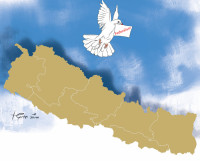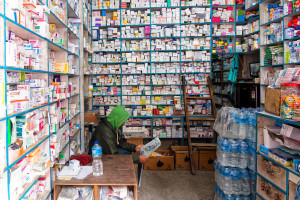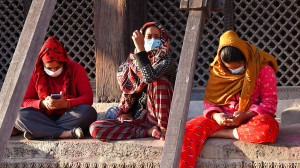Opinion
Politics of partnership
Regional tensions have been a major bottleneck to regionalism and neighbourly diplomacy through Saarc
Som P. Pudasaini
Though the South Asian Association for Regional Cooperation (Saarc) was born with economic growth through regional cooperation as a primary objective of its charter, it has made wobbly progress in the course of 17 summits in the 29 years since its birth in 1985. The major weaknesses within Saarc have been undue trust deficit, inadequate commitment, perceived or real interference in internal affairs, territorial or border disputes, and an inability to implement its own directives. With the high trust deficit, the task of managing suspicions and conflicts has drained the region of its energies. While many of its declarations, policies, and programmes are often sensible, they are not adequately turned into practical actions. To be effective, Saarc must evolve its current largely declarative mode towards improvements in implementation.
Regional tensions
Harmonious relations, dispute resolution, and adequate connectivity are critical for enhancing regional integration and prosperity in South Asia. Recent Saarc summits have been increasingly committed to strengthening connectivity and regional integration. During the 14th Saarc summit in Delhi in April 2007, then Prime Minister Man Mohan Singh stressed the need for Saarc to foster “connectivity—physical, economic and of the mind” to fully utilise regional resources and “flourish” through connection to “itself and the rest of the world”. In addition, the 17th Saarc summit, held in the Maldives on the theme ‘Building Bridges’, concluded with comprehensive agreements aimed at improving intra-Saarc connectivity.
Tensions between Pakistan and India, two of Saarc’s most important and powerful member states, are the biggest bottleneck for the promotion of regionalism and neighbourly diplomacy. The ‘New Beginning’ expected to start with Pakistani PM Nawaz Sharif’s participation at Narendra Modi’s inauguration as India’s prime minister has not made any constructive difference in the continuing tense Indo-Pak relations. In fact, Sharif addressed the United Nations General Assembly on September 26 by strongly raising the issue of Kashmir and the non-implementation of the 1948 UN Resolution. The following day, Modi addressed the Assembly, stressing that the UN is not the right forum to raise bilateral issues. He further claimed that dialogue with Pakistan would only be possible in a peaceful environment “without the shadow of terrorism”. Relations have further tensed as the death toll from early October cross-border violence in Kashmir rose to 17 and thousands of civilians living on both sides of the border fled their homes.
Rising China
India also feels insecure as China’s influence over its neighbourhood increases. This is especially true of increasing China-Pakistan camaraderie. China’s interest in the region and its alliance with Pakistan is well-established and is being continually strengthened. The operation of the Gwadar port, located near the Strait of Hormuz, was handed to the China Overseas Port Holding Co in view of China’s plan to secure maritime hubs around the Indian Ocean. They are also moving towards the construction of a New Economic Corridor from Kashgar (in Xinjiang) to Gwadar. China has also made moves to improve road links and modernise harbours across South Asia. Overall, Beijing is strengthening its political, economic, security, and trade relations with Saarc states. The rising influence of China in the region adds to India’s sense of insecurity and periodically colours its relationship with other member states.
India’s tension with China results from border issues as well as competition for strategic leadership in South Asia and beyond. The border issue dates back to 1914, when Britain signed an agreement with Tibet making the McMahon Line the de-facto border, which the People’s Republic of China does not accept. However, India’s trade with China is almost $70 billion and likely to reach $100 billion soon, with the trade deficit surging to over $40 billion from $1 billion in 2001-2002. During Chinese President Xi Jinping’s India visit in September 2014, Modi and Xi agreed to “revitalise” the Indo-Chinese relationship and pledged to work toward peace at the disputed border. In addition, India and China signed 12 agreements, including one in which China agreed to invest $20 billion in India’s infrastructure over five years. Modi and Xi seem to have developed good dynamics. Only time will tell how much this dynamics bodes well for stabilising Saarc and India’s relations. In addition, President Xi has also been promoting the ‘New Silk Road’ and the ‘New Maritime Silk Road’ concepts. He has been requesting India and other South Asian nations to participate in his efforts. How India and others respond to the call will also have ramifications for Saarc cooperation.
In this context, a contentious suggestion by Imtiaz Ahmed, a senior professor at Dhaka University in Bangladesh, is to offer full membership in Saarc to China, which only has observer status as of now. Ahmed argues for this as China is already “the largest trading partner of almost all the South Asian countries, including India”. It is also the largest development partner of many countries, including Pakistan. Beijing’s inclusion as a full member would only “rejuvenate Saarc as an economic region” in addition to helping it “overcome its current limitations resulting from the irreconcilable differences between Pakistan and India”. India is unlikely to accept such a proposal soon and whether such an initiative will strengthen its dynamics will also be dependent on improvement in overall relations.
Not converging yet
IP Khosla in his 2014 book How Neighbours Converge says there are three necessary preconditions for regional cooperation to succeed. First, there needs to be an absence of intraregional coercion, which tends to negate all cooperative efforts. Second, states must accept each other’s sovereignty and legitimacy. Third, there needs to be “a mutual dispute settlement system that is seen as impartial enough to inspire trust among the participating states”. If any of the three is absent, Khosla argues that “regional cooperation may go forward in hesitating steps, but has little chance of sustained success”. He notes that none of these conditions exist in South Asia. To date, Khosla claims that “the unifying force of common norms and values has been sufficient to prevent Saarc from breaking”. But this force has yet to generate sufficient utilitarian self-interest to take regionalisation forward. Instead, the state of Saarc regionalism will be dependent on its leaders and their dynamics.
It is true that Saarc has lost decades with only limited progress (such as the Saarc Development Fund, Saarc University, Saarc Secretariat, Saarc Regional Centers, and Safta) and is plagued by many woes. It is, however, unlikely to become irrelevant soon. The question is whether Saarc leaders can now rise above petty national interests. The 18th Saarc Summit, scheduled for November 26-27 in Kathmandu may be a good opportunity for leaders to seriously review past performance. Taking stock of contemporary realities, lessons learned, and expectations of the peoples of the member states, leaders may demonstrate their maturity by planning out concrete, time-bound, and implementable initiatives to promote South Asian regional integration and prosperity. Better connectivity and conflict management must be a core part of any such plan.
Pudasaini is a former UNFPA Representative in Sri Lanka and Yemen and former Country Director for the Maldives.




 9.12°C Kathmandu
9.12°C Kathmandu
.jpg&w=200&height=120)







%20(1).jpg&w=300&height=200)

